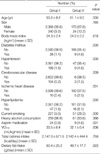1. Kannel MB, Wolf PA, Verter J, McNamara PM. Epidemiologic assessment of the role of blood pressure and stroke: the Framingham study. JAMA. 1970. 214:301–308.
2. Whisnant JP, Fitzgibbons JP, Kurland LT, Sayre GP. Natural history of stroke in Rochester, Minnesota, 1945 through 1954. Stroke. 1971. 2:11–22.

3. Park KC, Kim DI, Lee SJ, Lee BB, Lee CH, Kim DY, Heo JS, Kim YI. Prevalence of asyptomatic carotid atherosclerosis in Korea. J Korean Soc Vasc Surg. 1999. 15:228–233.
4. Executive Committee for the Asymptomatic Carotid Atherosclerosis Study. Endarterectomy for asymptomatic carotid artery stenosis. JAMA. 1995. 273:1421–1428.
5. Kannel WB, Dawber TR, Kagan A, Revotskie N, Stokes J 3rd. Factors of risk in the development of coronary heart disease--six year follow-up experience. The Framingham Study. Ann Intern Med. 1961. 55:33–50.
6. Kullo IJ, Ballantyne CM. Conditional risk factors for atherosclerosis. Mayo Clin Proc. 2005. 80:219–230.

7. Hackam DG, Anand SS. Emerging risk factors for atherosclerotic vascular disease: a critical review of the evidence. JAMA. 2003. 290:932–940.
8. Pearson TA, Mensah GA, Alexander RW, Anderson JL, Cannon RO 3rd, Criqui M, Fadl YY, Fortmann SP, Hong Y, Myers GL, Rifai N, Smith SC Jr, Taubert K, Tracy RP, Vinicor F. Centers for Disease Control and Prevention. American Heart Association. Markers of inflammation and cardiovascular disease: application to clinical and public health practice: A statement for healthcare professionals from the Centers for Disease Control and Prevention and the American Heart Association. Circulation. 2003. 107:499–511.
9. Fabris F, Zanocchi M, Bo M, Fonte G, Poli L, Bergoglio I, Ferrario E, Pernigotti L. Carotid plaque, aging, and risk factors. A study of 457 subjects. Stroke. 1994. 25:1133–1140.

10. Fine-Edelstein JS, Wolf PA, O'Leary DH, Poehlman H, Belanger AJ, Kase CS, D'Agostino RB. Precursors of extracranial carotid atherosclerosis in the Framingham Study. Neurology. 1994. 44:1046–1050.

11. Sorof JM, Alexandrov AV, Garami Z, Turner JL, Grafe RE, Lai D, Portman RJ. Carotid ultrasonography for detection of vascular abnormalities in hypertensive children. Pediatr Nephrol. 2003. 18:1020–1024.

12. Ross R. Atherosclerosis--an inflammatory disease. N Engl J Med. 1999. 340:115–126.
13. Ridker PM, Stampfer MJ, Rifai N. Novel risk factors for systemic atherosclerosis: a comparison of C-reactive protein, fibrinogen, homocysteine, lipoprotein (a), and standard cholesterol screening as predictors of peripheral arterial disease. JAMA. 2001. 285:2481–2485.

14. Szirmai IG, Kamondi A, Magyar H, Juhasz C. Relation of laboratory and clinical variables to the grade of carotid atherosclerosis. Stroke. 1993. 24:1811–1816.

15. Humphries SE, Morgan L. Genetic risk factors for stroke and carotid atherosclerosis: insights into pathophysiology from candidate gene approaches. Lancet Neurol. 2004. 3:227–235.







 PDF
PDF ePub
ePub Citation
Citation Print
Print




 XML Download
XML Download